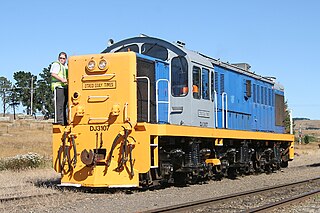
The New Zealand DJ class locomotive is a type of diesel-electric locomotive in service on the New Zealand rail network. The class were built by Mitsubishi Heavy Industries and introduced from 1968 to 1969 for the New Zealand Railways Department (NZR) with a modernisation loan from the World Bank to replace steam locomotives in the South Island, where all of the class members worked most of their lives. Nine of the locomotives remain in use, mainly with Dunedin Railways.
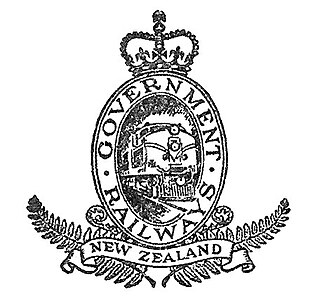
The New Zealand Railways Department, NZR or NZGR and often known as the "Railways", was a government department charged with owning and maintaining New Zealand's railway infrastructure and operating the railway system. The Department was created in 1880 and was corporatised on 1 April 1982 into the New Zealand Railways Corporation. Originally, railway construction and operation took place under the auspices of the former provincial governments and some private railways, before all of the provincial operations came under the central Public Works Department. The role of operating the rail network was subsequently separated from that of the network's construction. From 1895 to 1993 there was a responsible Minister, the Minister of Railways. He was often also the Minister of Public Works.
This is a list of jargon commonly used by railfans and railway employees in New Zealand.
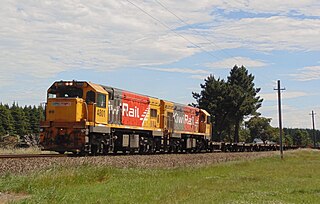
The New Zealand DC class locomotive is a type of diesel-electric mainline locomotive on the New Zealand rail network, operated by KiwiRail on freight trains, and formerly on long-distance passenger trains. The class was rebuilt from the DA class in the late 1970s and early 1980s, mainly in Australia. After the DA class, they were the most numerous class of diesel locomotive on New Zealand's railway network and remained numerically dominant until the mid-2010s when withdrawals began.
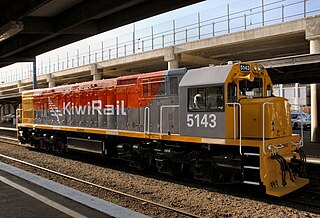
The New Zealand DX class locomotive is a type of diesel-electric locomotive that currently operates on New Zealand's national railway network. There are 49 of the locomotives and all are owned by KiwiRail. They have a Co-Co wheel arrangement.

The New Zealand DA class locomotive is a class of diesel-electric mainline locomotives operated on the New Zealand railway system between 1955 and 1989. Consisting of 146 locomotives, it is the most numerous class to ever operate in New Zealand, with five more than the AB class steam locomotive.

The New Zealand DB class and DBR class locomotive is a type of diesel-electric locomotive built for service on New Zealand's rail network. They were built by General Motors Diesel (GMD) of Canada as a narrow-gauge version of the EMD G8 model, with seventeen locomotives constructed. Ten of these were later rebuilt into the DBR class.

The New Zealand DG and DH class were classes of forty-two diesel-electric locomotives operated on New Zealand's rail network between 1955 and 1983.

The New Zealand DE class was a class of fifteen diesel-electric shunting locomotives, introduced by the New Zealand Railways (NZR) with an intention to replace steam locomotives on shunting duties with diesel power. The class was physically similar to the Tasmanian Government Railways X class, which was also of English Electric design.

The New Zealand DM/D class electric multiple unit were a type of electric multiple units used on the suburban rail network of Wellington, New Zealand. Formed of DM power cars and D trailer cars, the first units were ordered from English Electric in 1936 and introduced on 2 July 1938 operating the electrified Johnsonville Line service. Additional units were ordered in 1942 for the line, and in 1946 as the other Wellington suburban lines were to be electrified.

The New Zealand EM/ET class electric multiple units were used on suburban services in Wellington, New Zealand from 1982 to 2016. They were owned initially by the New Zealand Railways Corporation and finally by the Greater Wellington Regional Council (GWRC) and operated by Tranz Metro, part of national railway operator KiwiRail.

The NZR WF class were steam locomotives designed, built and used by New Zealand Railways (NZR). Their wheel arrangement is described by the Whyte notation 2-6-4T and the first members of the class entered service in 1904. The locomotives were tank engines designed by the Railways Department's Chief Mechanical Engineer A. L. Beattie, and were mainly built for suburban duties such as those between Christchurch and Lyttelton. They also saw main-line service in the Taranaki region, but most of the class members were assigned to branch line and local services throughout the country. Two were experimentally converted to oil burners in 1909-1910. The tests were satisfactory, but as coal was much cheaper than oil at the time, no further conversions took place.

The 8.38 miles (13.49 km) Tawa Flat deviation is a double-track section of the Kapiti Line just north of Wellington, New Zealand, with two tunnels; the southernmost section of the North Island Main Trunk railway (NIMT) between Wellington and Auckland. It was built to bypass a limited capacity single track section of the original Wellington and Manawatu Railway (WMR) line which ascended from Wellington to Johnsonville and then descended to Tawa Flat. The original name of Tawa Flat was changed to Tawa in 1959.
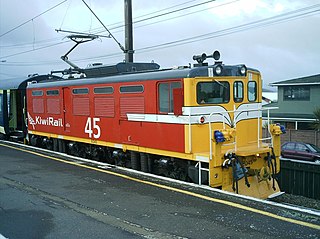
The New Zealand EA class of electric locomotives were used on the New Zealand rail network between 1968 and 1997 on the Otira – Arthur's Pass section of the Midland line in the South Island, through the Otira Tunnel. Following reconditioning, three were used by KiwiRail's Tranz Metro in Wellington from 2008 to 2011 to top and tail Metlink suburban passenger trains as an interim measure before new rolling stock arrived. Four of the five locomotives were scrapped in 2013 with one being set aside for preservation.
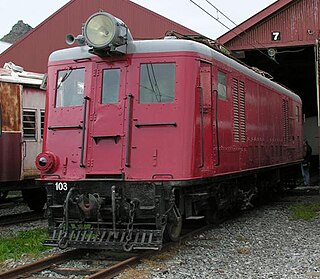
The NZR ED class locomotive was a type of electric locomotive used in Wellington, New Zealand. They were built by English Electric and the New Zealand Railways Department (NZR) between 1938 and 1940, and hauled mainly passenger trains on the Wellington region's 1500 V DC electrification, and banked freight trains on the steep section between Paekākāriki and Pukerua Bay.

Lyttelton Line is a name sometimes used to refer to the section of the Main South Line in New Zealand's South Island between Lyttelton and Christchurch, and can also be used to refer to the operations on this section. As it has always been part of the Main South Line, this name has never been officially used to refer to the track itself.
The NZR DS class locomotive is a type of 16 diesel shunting locomotives built by the Vulcan Foundry and supplied by the Drewry Car Co from 1949–1955, for New Zealand Railways (NZR).

The Wellington and Manawatu Railway Company was a private railway company that built, owned and operated the Wellington-Manawatu railway line between Thorndon in Wellington, the capital of New Zealand, and Longburn, near Palmerston North in the Manawatu, between 1881 and 1908, when it was acquired by the New Zealand Government Railways. Its successful operation in private ownership was unusual for early railways in New Zealand.
Railway electrification in New Zealand consists of three separate electric systems, all on the North Island. Electrification was initially adopted by the New Zealand Railways for long tunnels; the Otira Tunnel, the Lyttelton Rail Tunnel and the two Tawa Tunnels of the Tawa Flat Deviation. Electrification of Wellington suburban services started with the Johnsonville Line and Kapiti Line out of Wellington from the 1930s. Auckland suburban services were electrified in 2014–2015. Electrification of long-distance services on the North Island Main Trunk (NIMT) dates from 1986. New long tunnels, for example the Rimutaka Tunnel and the Kaimai Tunnel, were operated by diesels, and the Otira and Lyttelton Tunnels have converted to diesel operation.

The North–South Junction is a section of single-track rail line about 7 km long, north of Wellington, New Zealand between the closed (2011) Muri railway station and the (lower) Paekakariki railway station to the north. It is part of the Kapiti Line section of the North Island Main Trunk line between Wellington and Auckland, and part of the Wellington–Manawatu Line, built by the Wellington & Manawatu Railway Company (WMR).



















